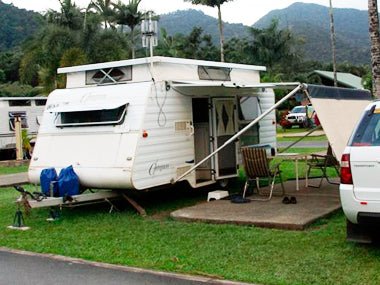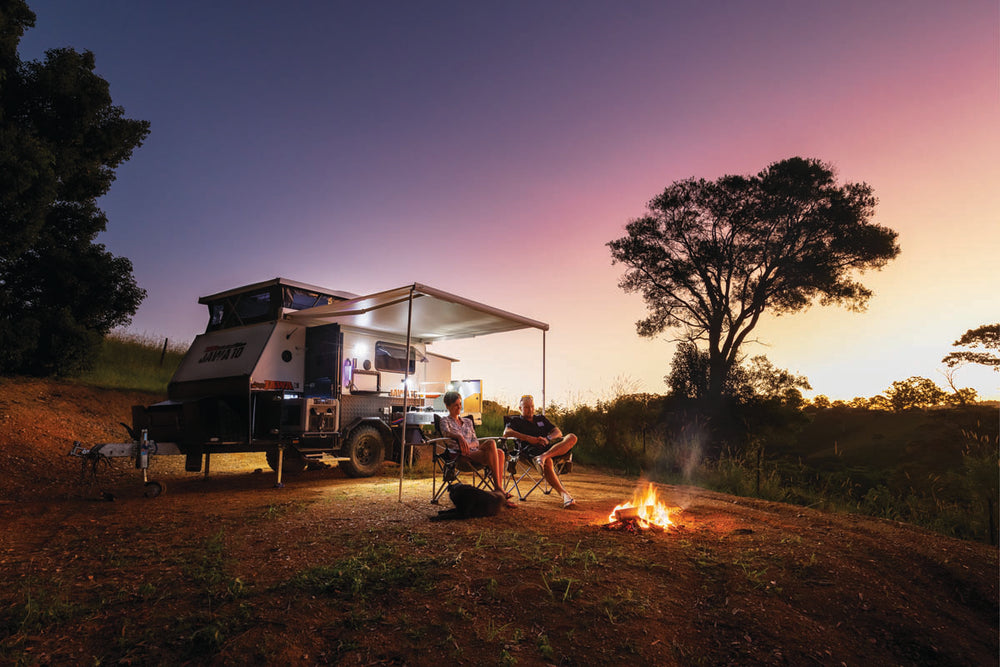Feature: Keeping Your Cool

Around nine years ago, Denyse and I designed our own caravan and had it built by Roadstar/Compass. Because the majority of our travelling is done in the northern part of Australia, keeping our van cool was a big consideration.
Here are some of our thoughts.
POP-TOP OPTION
Not surprisingly, a pop-top van is cooler than a full van. We all know that hot air rises, and a pop top has the advantage of vents in the top skirt to let hot air out and cross breezes in.
We had our roll-out awning fixed to the body of the van, rather than the pop-top roof. This means that hot air trapped under the awning does not feed into the van via the vent in the pop-top skirt.
The other advantages of this system are that the awning can be rolled and unrolled without adjusting the pop-top. This idea is much easier to incorporate at the building stage, as setup may require a three-quarter door, or to alter the position of the light.
We also have sail tracks on both sides of the van. This allows us to attach a cloth awning to the drum of our pull-out awning so that it falls to the ground, much like an annex wall, or install it on the other side of the van for an offside awning.
NECESSARY INSULATION
Insulation is a must. Most vans have insulation in the roof, but not all vans have full body insulation. If you are having a new van built, insist on full body insulation.
I painted the roof with insulating paint. There are a couple of suppliers, but we chose Australian Paints (Beenleigh, Qld) which I reviewed in CW a few years ago. It’s an excellent product that really lowers a van’s internal temperature. Make sure you follow the instructions though, and allow the suggested drying time.
INSIDE THE VAN
Keeping your fridge cold can be a problem. Denyse and I spend a lot of time in national parks and offroad, so we chose a three-way Dometic. When designing our caravan, we made sure to locate the fridge on the same side as the awning so it mostly remains under shade. Most people prefer to park with the awning facing east, or away from the hot afternoon sun, and it’s a bonus if your fridge is also on this side.
Our van has an island double bed at the rear. We have a large rear window to match the front one, with a matching stone cover. This allows us to leave the window open even on humid, steamy summer nights in Cairns or Darwin, and the cover provides shade.
THE POWER TO COOL
Halogen and incandescent lights are very hot (and in the case of halogen, have a high UV emission). Our choice instead was 12V fluoros throughout. Each light can be used as one, two or three 8W tubes, depending on need. They draw very little power, give excellent light and run cool. LEDs are also a good option.
As we prefer not to use a generator (and you can’t use them in most national parks anyway), we included plenty of 12V and 240V power points. This means we can use either 12V or 240V fans no matter where we park. We purchased a good quality 12V marine fan which is quiet, reliable and uses little power. We also carry a smaller 240V fan for use in van parks.
TO A/C OR NOT TO A/C
Air-conditioning is an obvious choice. We decided against it due to the noise and the need to close our van’s windows and doors. We’ve camped near folk before who chose to run their air-con off a generator in an offroad camp – and to add insult to injury, left all their windows open so it cut in and out all night. You’ve probably had a similar experience.
As an alternative, shady trees seem attractive in hot weather. Apart from the risk of falling branches, the fallout of leaves, fruit and bird or bat droppings can be very unpleasant. A better solution is to camp with a large shady tree a little way away on your western side. This will keep the sun out when it’s at its strongest. -- Tony Allsop







